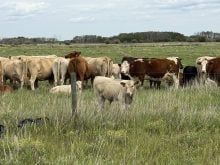This cattle market information is selected from the weekly report from Canfax, a division of the Canadian Cattlemen’s Association. More market information, analysis and statistics are available by becoming a Canfax subscriber by calling 403-275-5110 or at www.canfax.ca.
Historic highs for fed
Alberta fed cattle prices established new historic highs again last week. The bulk of weekly trade was reported $3-$9 per hundredweight higher than the previous week dressed from $360-$362 per cwt. delivered and was steady to $2 per cwt. higher than Ontario dressed trade.
Read Also

Government, industry seek canola tariff resolution
Governments and industry continue to discuss how best to deal with Chinese tariffs on Canadian agricultural products, particularly canola.
Alberta dressed prices have not traded par or stronger than Ontario since December 2021. Weighted average Ontario steer prices did maintain a $1.37 per cwt. premium to Alberta, while average heifer prices converged.
Western Canadian fed slaughter for the week ending March 25 was three percent larger than the previous week at 42,752 head. Year-to-date western fed slaughter was two percent lower than year ago, totalling 496,435 head.
Canadian and western Canadian steer carcass weights eased six pounds lower than the previous week to 910 and 895 lb., respectively. Canadian steer weights were 12 lb. lower than the same week last year, but year to date are six lb. heavier at 934 lb.
Fed cattle/cow exports to the United States for the week of March 18 were 24 percent larger than the previous week, totalling 12,476 head, and 11 percent larger than year ago. Year-to-date exports were five percent lower than the same week last year totalling 111,524 head.
Ontario fed prices continued record high with steers and heifers averaging $215.10 and $213.31 per cwt., respectively. Dressed sales were fully steady with the previous week at $360 per cwt. Seasonal price upside is still anticipated in the fed market. Strong prices will pull calves forward during the first half of April, and carcass weights should trend seasonally lighter through the second quarter.
In the U.S., light to moderate trade in the south saw live prices US$2-$5 per cwt. higher than the previous week from $165-$168 per cwt. Northern live trade was around $4-$7 per cwt. stronger from $168-$172, and most dressed sales were reported from $270-$272 per cwt. delivered.
For the week ending March 18, steer carcass weights eased four lb. lower than the previous week to 899 lb. and were sharply 17 lb. lower than year ago.
Total U.S. slaughter was an estimated four percent larger than the previous week and two percent larger than a year ago at 651,000 head.
Cow prices mixed
The market tone was mixed last week with D2 cows trading $2 per cwt. weaker to average $132.50, while D3 cows were $5 per cwt. stronger, averaging $119.13 per cwt.
Alberta D2 cow prices recently shifted to a slight premium against the U.S. market. Alberta cow prices are the highest in North America. Slaughter bulls averaged $149.06 per cwt.
For the week ending March 25, western Canadian cow slaughter totalled slightly more than 7,300 head, 14 percent larger than last year. This is the 20th consecutive week cow slaughter has been higher than last year.
Non-fed prices are $17-$23 per cwt. shy of their all-time highs set in the spring of 2015. With the historically strong run-up in prices over the past 90 days, producers who put cows on feed during the fourth quarter of 2022 are likely profitable if they marketed their cows today.
Ontario cow prices traded fully steady last week. Eastern Canadian cow slaughter totalled 2,500 head. For the second half of March this is the largest cow slaughter since 2012.
More heifer sales
A few more replacement heifer sales were highlighted over the past couple of weeks, and demand has been mixed. First-cut heifers are finding homes in breeding programs, while second-cut heifers are ending up in the feedlot.
Open replacement heifers have been trading $1,900-$2,400 per head. Last week, Alberta 900-1,000 lb. heifers for September delivery traded from $254-$261 per cwt.
Quite a few forward delivery yearlings have traded over the past couple of months, but there has not been much activity on the forward delivery calf market.
Cutouts steady
In U.S. beef trade, Choice and Select cutouts trended mostly steady. Choice traded within US$1 per cwt. of $280 but eased 1.3 percent lower to $279.20 per cwt. on March 30. Select traded in the $269 per cwt. range and closed the week steady with the previous week at $268.46.
















